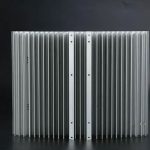Brass is an alloy composed of copper and zinc. Brass composed of copper and zinc is called ordinary brass. Brass is often used to make valves, water pipes, connecting pipes for internal and external air conditioners, and radiators.
It is an alloy composed of copper and zinc.
When the zinc content is less than 35%, zinc can be dissolved in copper to form a single-phase a, called single-phase brass, which has good plasticity and is suitable for cold, hot, and pressurized processing.
When the zinc content is 36%~46%, there are a single phase and a β solid solution based on copper and zinc, called dual-phase brass. The β phase reduces the plasticity of the brass and increases the tensile strength, which is only suitable for Hot pressure processing.
If you continue to increase the mass fraction of zinc, the tensile strength will decrease and there will be no use value.
Recycling of renewable resources has a certain scale. Since the reform and opening up, with the support of a series of national preferential policies to encourage the recycling and utilization of renewable resources, my country’s waste material recycling industry has developed rapidly, and a renewable resource recycling and processing system has initially taken shape. At present, there are more than 5,000 recycling companies of various types of waste materials, 160,000 recycling outlets, more than 3,000 recycling and processing plants, and more than 1.4 million employees. According to incomplete statistics, my country’s recycling volume of renewable resources exceeded 5,000 in 2000. The total annual recycling value is 45 billion yuan; the annual processing and pretreatment capacity of the main types of waste materials recycling enterprises reaches more than 20 million tons. The dismantling capacity of scrap vehicles, ships and mechanical equipment is nearly 10 million tons. The processing quality is greatly improved. At present, a renewable resource recovery and processing system covering the whole country and network has taken shape.
The value of scrap brass recycling is particularly high, because its market value is high, so the recycling rate is high, and the market price will also change with changes in the market economy. If you seize the business opportunity, act immediately.
Brass has been recorded in ancient times. It can be seen that the use of brass has won the hearts of the people. The term brass refers to copper-zinc alloys, which was originally recorded in the Ming Dynasty. The record can be found in the Minghuidian: “Jiajing Zhong As an example, Tongbao coins are 6 million liters, and the two-fire brass is 47,272 catties…” Through the analysis of the composition of the copper coins in the Ming Dynasty, it is found that the coin-casting species mentioned in the “Ming Hui Dian” The appearance of brass in the true sense was much later than that of other copper alloys. This is because it is more difficult to obtain metallic zinc in brass.
The recycling of waste brass also provides a lot of resources for the production of many brass products. Waste brass can also be reused many times. Meaningful waste brass recycling requires constant persistence. In fact, all Waste brass can be recycled. The regeneration process is very simple. Firstly, the collected waste brass is sorted. The waste brass that is not contaminated or the brass alloy of the same composition can be used directly after re-melting. The waste brass that is heavily contaminated should be further refined to remove impurities; Brass alloy scraps need to be adjusted after melting. Through such regeneration treatment, the physical and chemical properties of brass are not damaged, so that it can be completely renewed.
Achieving better brass reuse requires a streamlined process and a more complete recycling of waste brass.
Link to this article:Waste brass recycling realizes multiple use of resources
Reprint Statement: If there are no special instructions, all articles on this site are original. Please indicate the source for reprinting:Alloy Wiki,thanks!^^







